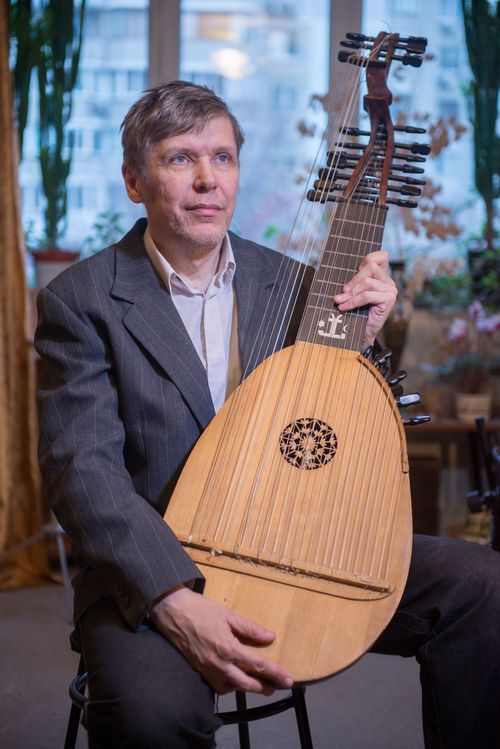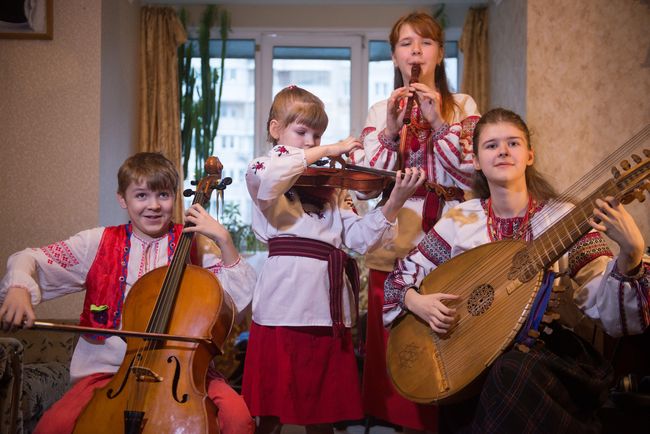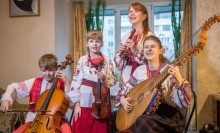Ukrainians see torban every day, but only few of them play it. The string music instrument, which was popular in the 18th century, a relative of lute, was destroyed partially in the time of the Russian Empire, and partially – in Soviet time. Now the simplest way to see torban is to look at the backside of the 10-hryvnia banknote, where it is depicted. Probably, it is not accidental that the instrument is pictured next to Ivan Mazepa’s portrait – pictures of the hetman’s torbans have been preserved.
Master of music instruments Vadym Viksnin started to revive torbans nearly 10 years ago. In particular, he made a precise copy of Mazepa’s torban. At home Vadym has a music ensemble. His five children study music, play cello, violin, and flute. The master’s daughter Maria Viksnina, among other instruments, plays torban as well. The Day has visited Viksnin and learned a few secrets of the ancient Ukrainian instrument.
MAZEPA’S COAT OF ARMS MADE OF GRAND PIANO KEYS
Vadym Viksnin holds a precise copy of one of Mazepa’s torbans on his lap. The master made it according to the description, which used to be stored at Chernihiv History Museum. The instrument was destroyed during the liberation of the city from Germans – the museum secret deposit was crashed. “The torban was girdled with a maple ribbon – here it is,” Vadym Viksnin shows his creation, “The instrument was also girdled with 32 strips of rosewood tree, whereas the pins and the neck cover – of ebonite tree. Mazepa’s coat of arms was made of ivory – I cut it from the keys of prerevolutionary grand piano.” The master’s daughter Maria used to perform with this instrument often, but it got broken past year. Vadym Viksnin has made a new torban, probably he will repair the old one in the future.

THE ORIGINS OF THE INSTRUMENT
There are several versions of the instrument’s origins. “Poles consider torban a Ukrainian instrument, and Ukrainians consider it a Polish one. Not to work with the instrument, we need to ascribe it to someone else,” Vadym Viksnin smiles. The master admits that Austria may be the country of the origin of torban. “One of the first well-known torban players came from the family of Vidarts,” Viksnin explains, “He was born in the late 18th century in Austro-Hungary. He played in an interesting way: he placed the instrument on his lap horizontally. This is the way musicians play Austrian zither. And torban, according to my research, was a predecessor of zither.” Torban was spread in Rzeczpospolita, almost everyone in Polish nobility played the instrument, including the Cossack leaders.
The instrument was popular in Russia too. In St. Petersburg today there is a big torban collection. “Nearly all prerevolutionary writers of Ukraine and Russia mention torban, which later was heavily eradicated. Saltykov-Schedrin, Leo Tostoy, and some of the Decembrists mention the instrument,” Viksnin lists.
OBLIVION
The destruction of the instrument started in the time of the Russian Empire, the process reached its summit in Soviet time. “Most of the songs for torban glorified the Cossack honor and the Ukrainian weapons. Besides, Hetman Mazepa, who is still anathematized in all Russian churches, used to play the instrument too,” Vadym Viksnin explained. “In a dictionary of 1917-18 it is written that because torban was complicated in terms of making and its performance technique was difficult – although torban was used in everyday life of commoners – the instrument was found non-promising and it should fall into oblivion. On the whole, in Soviet time all Ukrainian instruments used for performing classical music were destroyed.”
...AND REVIVAL
Although Vadym Viksnin had bandurists and violin masters among his ancestors, he started to take interest in torban quite accidentally. “For my whole life I have been making violins and repairing pianos. During perestroika and at the beginning of independence we didn’t have money. I had to maintain my family, so I found a job at a furniture factory,” Viksnin recalls, “All of a sudden an acquaintance of mine said that someone wanted to order a hurdy-gurdy and was looking for a master to do this. I was glad, the proposal seemed interesting, I promised to give it a thought. I started to study the materials on wheel lyre, kobza, bandura, later I came up to torban.”

At first Viksnin played torban in one tonality. Then he was shocked as he read in a book by prerevolutionary researcher that musicians could play torban in different tonalities and performed refined authors’ works. Vadym Viksnin didn’t learn to play in a new way, but his daughter Maria has been playing torban for eight years, using all the possibilities of the instrument. There are few people like her in Ukraine, and in the world.
At the moment the master wants to make a new torban. It takes a lot of time, energy, and money to make such an instrument. The master’s only resource, which seems limitless, is his enthusiasm. “My colleagues from Germany, France, and America have been asking what funding or grants I have received from Ukraine. I keep silent, because I haven’t received any funding,” Vadym Viksnin shrugs his shoulders.
Hopefully, that torban, which was suddenly revived after 100-year-long oblivion, won’t disappear again.







